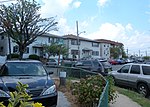Upper Bay Bridge
1930 establishments in New JerseyBridges completed in 1930Bridges in Hudson County, New JerseyCSX Transportation bridgesLehigh Valley Railroad ... and 5 more
Pennsylvania Railroad bridgesRailroad bridges in New JerseyTransportation in Bayonne, New JerseyTransportation in Newark, New JerseyVertical lift bridges in New Jersey

The Upper Bay Bridge, or the Lehigh Valley Railroad Bridge, is a vertical lift bridge spanning the Newark Bay in northeastern New Jersey. It is used by CSX Transportation travelling through the North Jersey Shared Assets Area of the United States rail network along the National Docks Secondary line. The bridge is just north and parallel to the New Jersey Turnpike's Newark Bay Bridge. A notable train using the bridge is the Juice Train, which originates in Florida.
Excerpt from the Wikipedia article Upper Bay Bridge (License: CC BY-SA 3.0, Authors, Images).Upper Bay Bridge
New Jersey Turnpike Newark Bay Extension,
Geographical coordinates (GPS) Address External links Nearby Places Show on map
Geographical coordinates (GPS)
| Latitude | Longitude |
|---|---|
| N 40.699052 ° | E -74.119574 ° |
Address
Upper Bay Bridge
New Jersey Turnpike Newark Bay Extension
07305
New Jersey, United States
Open on Google Maps








